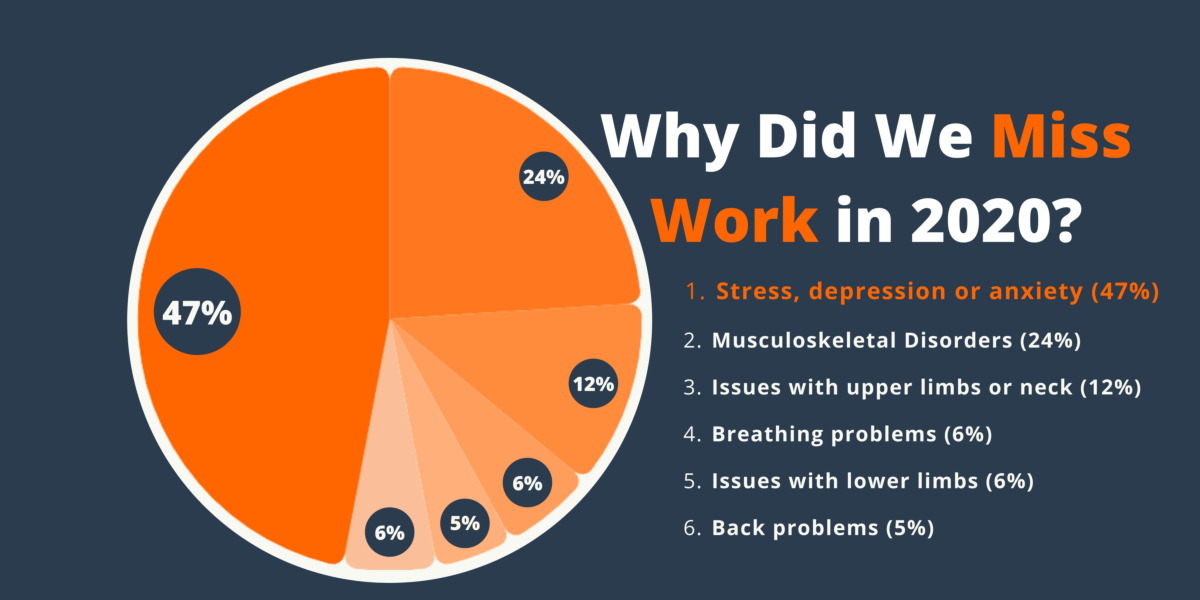Stress No.1 Reason Brits Miss Work (& Costs Employers £4541 Per Employee Every Year)
A new study by UK Sauna's wellbeing specailists has investigated the number of employees taking time off due to a range of work-induced illnesses.
Using a combination of data from HSE, ONS, and local search, the study seeks to answer the questions: how many employees are missing work because of work-related stress; how have these trends changed over the past 5 years; where in the UK is this issue most prevalent; which employees are the most impacted by work-related stress; and how much is stress costing UK businesses?
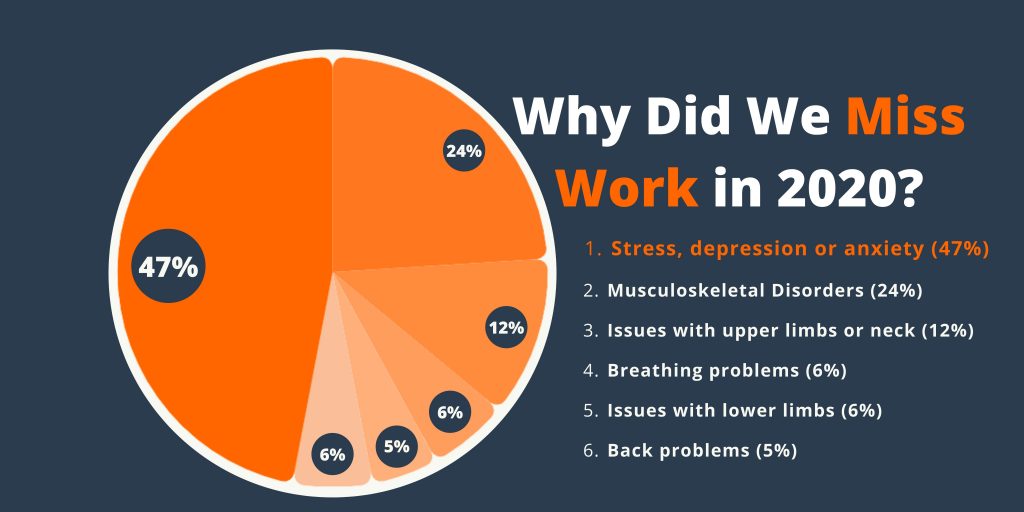 Reasons UK employees missed work in 2020[/caption]
Since 2014, the number of people experiencing work-related stress, anxiety and depression has increased at an unprecedented rate. In 2020 , 820, 000 UK employees reported feeling stressed out at work, citing office politics, lack of interdepartmental communications, job performance and tensions with managers as primary causes. According to experts, Covid-19 has not contributed significantly to work-related stress, suggesting, worryingly, that rates will continue to increase following the conclusion of the pandemic.
Reasons UK employees missed work in 2020[/caption]
Since 2014, the number of people experiencing work-related stress, anxiety and depression has increased at an unprecedented rate. In 2020 , 820, 000 UK employees reported feeling stressed out at work, citing office politics, lack of interdepartmental communications, job performance and tensions with managers as primary causes. According to experts, Covid-19 has not contributed significantly to work-related stress, suggesting, worryingly, that rates will continue to increase following the conclusion of the pandemic.
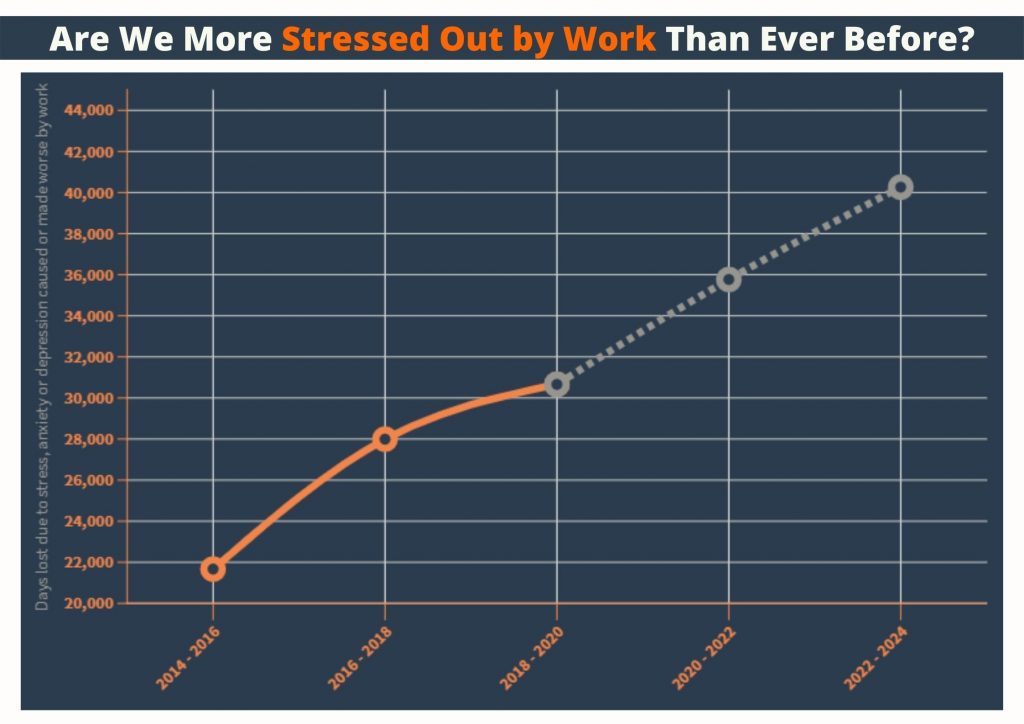 Days lost due to stress, anxiety or depression, 2014-2020, and predicted days lost 2021-2024[/caption]
In 2014, an estimated 1,247 (thousands) people were suffering from work-related stress, depression and anxiety. By 2020, this figure had increased by over 30%. If the current trend continues, the prevalence of work related stress, depression and anxiety will increase a further 30% by 2024.
Days lost due to stress, anxiety or depression, 2014-2020, and predicted days lost 2021-2024[/caption]
In 2014, an estimated 1,247 (thousands) people were suffering from work-related stress, depression and anxiety. By 2020, this figure had increased by over 30%. If the current trend continues, the prevalence of work related stress, depression and anxiety will increase a further 30% by 2024.
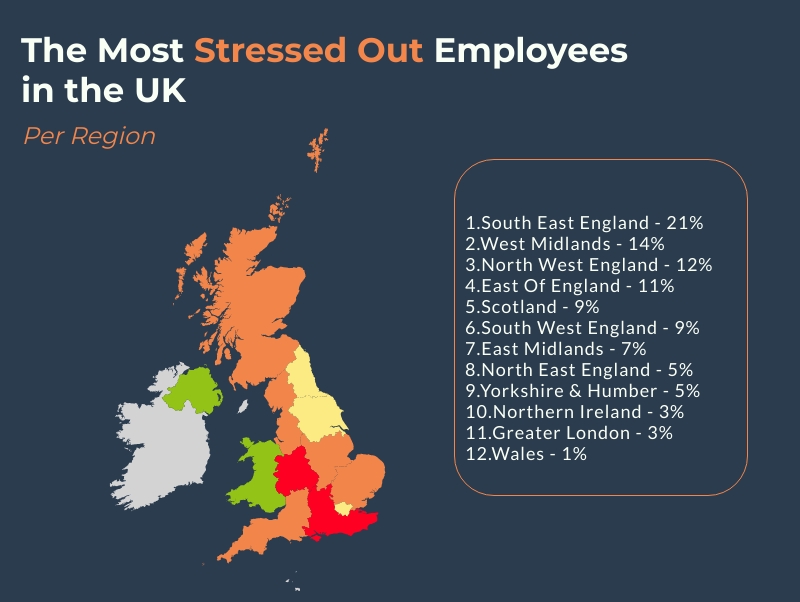 The most stressed out employees in the UK, per region (according to local search data)[/caption]
21% of searches for terms relating to stress at work were made in South East England, with Kent being the worst-hit county in the UK. Conversely, Wales was found to be the most content region with only a 1% share of searches.
The most stressed out employees in the UK, per region (according to local search data)[/caption]
21% of searches for terms relating to stress at work were made in South East England, with Kent being the worst-hit county in the UK. Conversely, Wales was found to be the most content region with only a 1% share of searches.
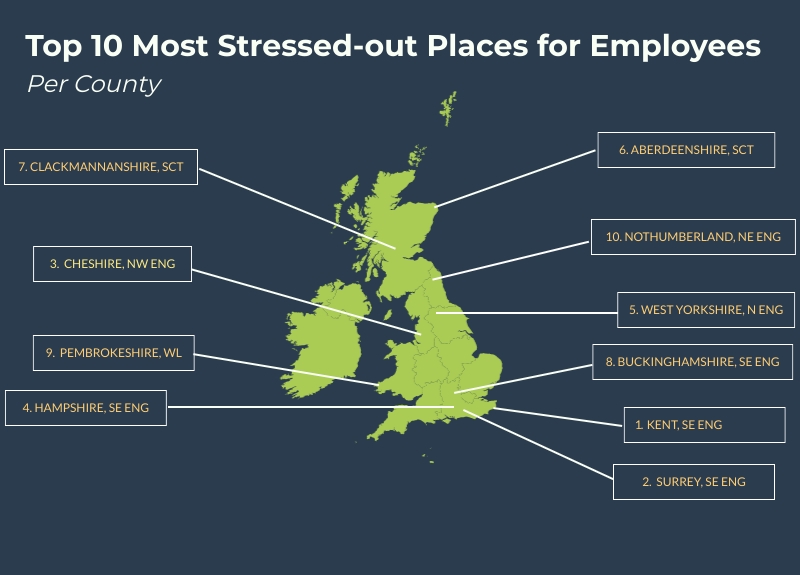 Top UK locations for stressed out employees, per county, 1-10, highest-lowest (according to local search volume)[/caption]
Top UK locations for stressed out employees, per county, 1-10, highest-lowest (according to local search volume)[/caption]
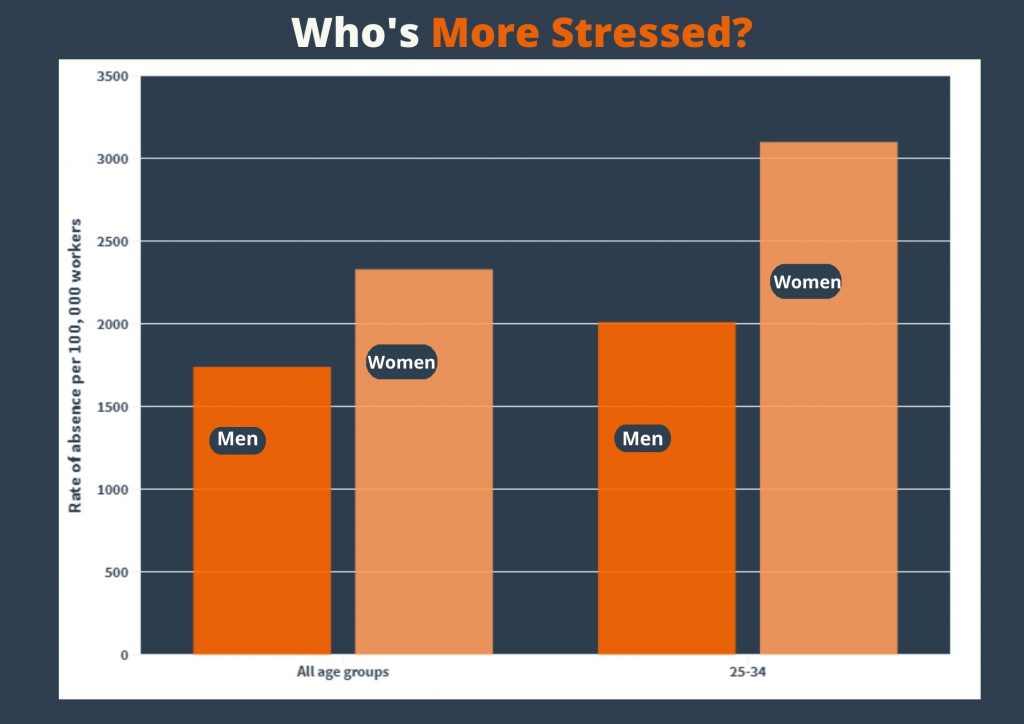 This could be attributed to lower pay, lack of potential for career progression, job insecurity and limited flexibility in regard to working hours.
This could be attributed to lower pay, lack of potential for career progression, job insecurity and limited flexibility in regard to working hours.
Key Findings
- Employees in Britain missed an estimated 32, 520, 000 days of work in 2020
- Work-related stress, anxiety, and depression constituted almost 50% of days missed from work in 2020.
- Both the prevalence and incidence of work-related stress, depression, and anxiety have dramatically increased since 2014.
- 21% of Google searches for terms relating to stress at work were made in South East England.
- Kent has the highest proportion of stressed-out employees in the UK.
- Women experienced more work-related stress than men between 2017-2020, particularly those in the 25-34 age group.
- Absences due to work-related stress, anxiety, and depression cost employers an average of £4541 per employee every year.
WHY UK EMPLOYEES MISSED WORK LAST YEAR
GRAPH 1: Reasons UK Employees Missed Work Last Year
In 2020, employees in Britain missed an estimated 32, 520, 000 days of work. Job-related stress, anxiety and depression made up almost 50% of this statistic. This costed employers an average of £4541 per employee each year. [caption id="attachment_1560" align="aligncenter" width="840"] Reasons UK employees missed work in 2020[/caption]
Since 2014, the number of people experiencing work-related stress, anxiety and depression has increased at an unprecedented rate. In 2020 , 820, 000 UK employees reported feeling stressed out at work, citing office politics, lack of interdepartmental communications, job performance and tensions with managers as primary causes. According to experts, Covid-19 has not contributed significantly to work-related stress, suggesting, worryingly, that rates will continue to increase following the conclusion of the pandemic.
Reasons UK employees missed work in 2020[/caption]
Since 2014, the number of people experiencing work-related stress, anxiety and depression has increased at an unprecedented rate. In 2020 , 820, 000 UK employees reported feeling stressed out at work, citing office politics, lack of interdepartmental communications, job performance and tensions with managers as primary causes. According to experts, Covid-19 has not contributed significantly to work-related stress, suggesting, worryingly, that rates will continue to increase following the conclusion of the pandemic.
GRAPH 2: Days Lost for Work-related Stress, Anxiety and Depression
[caption id="attachment_1559" align="aligncenter" width="840"] Days lost due to stress, anxiety or depression, 2014-2020, and predicted days lost 2021-2024[/caption]
In 2014, an estimated 1,247 (thousands) people were suffering from work-related stress, depression and anxiety. By 2020, this figure had increased by over 30%. If the current trend continues, the prevalence of work related stress, depression and anxiety will increase a further 30% by 2024.
Days lost due to stress, anxiety or depression, 2014-2020, and predicted days lost 2021-2024[/caption]
In 2014, an estimated 1,247 (thousands) people were suffering from work-related stress, depression and anxiety. By 2020, this figure had increased by over 30%. If the current trend continues, the prevalence of work related stress, depression and anxiety will increase a further 30% by 2024.
WHERE THE MOST STRESSED EMPLOYEES LIVE
According to additional research into local keyword data, the South East of England has the highest levels of workplace-stress.MAP 1: The Highest Number of Searches Relating to Work-place Stress (Per Region)
[caption id="attachment_1562" align="aligncenter" width="800"] The most stressed out employees in the UK, per region (according to local search data)[/caption]
21% of searches for terms relating to stress at work were made in South East England, with Kent being the worst-hit county in the UK. Conversely, Wales was found to be the most content region with only a 1% share of searches.
The most stressed out employees in the UK, per region (according to local search data)[/caption]
21% of searches for terms relating to stress at work were made in South East England, with Kent being the worst-hit county in the UK. Conversely, Wales was found to be the most content region with only a 1% share of searches.
MAP 2: The Top 10 Locations with Searches Relating to Work-place Stress (Per County)
Kent is home to the most stressed out employees in Britain, followed by Surrey and Cheshire. [caption id="attachment_1563" align="alignleft" width="800"] Top UK locations for stressed out employees, per county, 1-10, highest-lowest (according to local search volume)[/caption]
Top UK locations for stressed out employees, per county, 1-10, highest-lowest (according to local search volume)[/caption]
TABLE 1: The Top 10 Most Stressful Places for Employees
| Position | Location | Impressions | Population | County | Region |
| 1 | West Malling | 7.6 | 2,223 | Kent | South East England |
| 2 | Hindhead | 7.6 | 4,595 | Surrey | South East England |
| 3 | Tattenhall | 7.6 | 4,841 | Cheshire | North West England |
| 4 | Odiham | 7.6 | 5,721 | Hampshire | South East England |
| 5 | Bagshot | 7.48 | 5,920 | Surrey | South East England |
| 6 | Pontefract | 30.41 | 31,000 | West Yorkshire | North England |
| 7 | Hook | 7.6 | 7,770 | Hampshire | South East England |
| 8 | Portlethen | 7.48 | 9,090 | Aberdeenshire | Scotland |
| 9 | Alloa | 15.21 | 20,730 | Clackmannanshire | Scotland |
| 10 | Iver | 7.6 | 12,189 | Buckinghamshire | South East England |
WHO IS THE MOST AFFECTED?
In 2020, women experienced considerably more stress, depression and anxiety than their male counterparts. The highest incidences of stress, anxiety, and depression were reported by women in the 25-34 age group.GRAPH 3: Rates of Absence Relating to Stress, Anxiety or Depression (by gender)
 This could be attributed to lower pay, lack of potential for career progression, job insecurity and limited flexibility in regard to working hours.
This could be attributed to lower pay, lack of potential for career progression, job insecurity and limited flexibility in regard to working hours.



